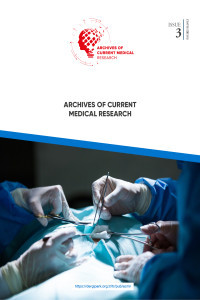Factors Affecting the Nutritional Habits of Cerebral Palsy Patients
Factors Affecting the Nutritional Habits of Cerebral Palsy Patients
Cerebral Palsy Dietary, Skin Thickness, Nutritional Problems.,
___
- 1. Papavasiliou AS. Management of motor problems in cerebral palsy: a critical update for the clinician. Eur J Paediatr Neurol. 2009;13(5):387- 96.
- 2. Pellegrino L, Dormans JP. Definitions, etiology and epidemiology of cerebral palsy. In: Pellegrino L, Dormans JP, editors. Caring for children with cerebral palsy: a team approach. Baltimore: Paul H. Brookes Publishing Company; 1998. p.3-30.
- 3. Krigger KW. Cerebral palsy: an overview. Am Fam Physician. 2006;73(1):91-100.
- 4. Stallings VA, Zemel BS, Davies JC, Cronk CE, Charney EB. Energy expenditure of children and adolescents with severe disabilities: a cerebral palsy model. Am J Clin Nutr. 1996;64(4):627-34.
- 5. Strauss D, Shavelle R. Life expectancy of adults with cerebral palsy. Dev Med Child Neurol. 1998;40(6):369-75.
- 6. Sleigh G, Brocklehurst P.Gastrostomy feeding in cerebral palsy: a systematic review. Arch Dis Child. 2004;89(6):534-9.
- 7. Stallings VA, Charney EB, Davies JC, Cronk CE. Nutritional status and growthof children with diplegic or hemiplegic cerebral palsy. Dev Med Child Neurol. 1993;35(11):997-1006.
- 8. Stallings VA, Charney EB, Davies JC, Cronk CE. Nutrition-related growth failure of children with quadriplegic cerebral palsy. Dev Med Child Neurol. 1993;35(2):126-38.
- 9. Savaşır I, Şahin NH. Bilişsel-davranışçı terapilerde değerlendirme: Sık kullanılan ölçekler. Ankara: Türk Psikologlar Derneği Yayınları 1997. p.1-52.
- 10. Del Giudice E, Staiano A, Capano G, Romano A, Florimonte L, Miele E, et al. Gastrointestinal manifestations in children with cerebral palsy. Brain Dev. 1999;21(5):307-11.
- 11. Erkin G, Kacar S, Özel S. Serebral palsili hastalarda gastrointestinal sistem ve beslenme problemleri. Turk J Phys Med Rehab. 2005;51:150- 155.
- 12. Gremse DA. GERD in the pediatric patient: management considerations. MedGenMed. 2004;6(2):13.
- 13. Öneş K, Çelık B, Çağlar N, Gültekın Ö, Yilmaz E, Çetınkaya B. Serebral palsi polikliniğine müracaat eden hastaların demografik ve klinik özellikleri. Turk J Phys Med Rehab. 2008;54:1316.
- 14. Benfer KA, Weir KA, Bell KL, Ware RS, Davies PS, Boyd RN. Longitudinal cohort protocol study of oropharyngeal dysphagia: relationships to gross motor attainment, growth and nutritional status in preschool children with cerebral palsy. BMJ Open. 2012;2(4):e001460.
- 15. Fung EB, Samson-Fang L, Stallings VA, Conaway M, Liptak G, Henderson RC, et al. Feeding dysfunction is associated with poor growth and health status in children with cerebral palsy. J Am Diet Assoc. 2002;102(3):361-73.
- 16. Rogers B. Feeding method and health outcomes of children with cerebral palsy. J Pediatr. 2004;145(2 Suppl):S28-32.
- 17. Yilmaz S, Basar P, Gisel EG. Assessment of feeding performance in patients with cerebral palsy. Int J Rehabil Res. 2004;27(4):325-9.
- 18. Dilek B, Batmaz İ, Karakoç M, Sarıyıldız MA, Aydın A, Çavaş H, et al. Serebral palsili çocukların annelerinde depresyon ve yaşam kalitesinin değerlendirilmesi. Marmara Medical Journal. 2013;26:94-8.
- 19. Arrowsmith FE, Allen JR, Gaskin KJ, Gruca MA, Clarke SL, Briody JN, et al. Reduced body protein in children with spastic quadriplegic cerebral palsy. Am J Clin Nutr. 2006;83(3):613-8.
- 20. Sert C, Altindağ O, Sirmatel F. Determination of basal metabolic rate and body composition with bioelectrical impedance method in children with cerebral palsy. J Child Neurol. 2009;24(2):237-40.
- 21. Pai M, Alur M, Wirz S, Filteau S, Pagedar S, Yousafzai A. A pilot study of the nutritional status of disabled and non-disabled children living in Dharavi, Mumbai. Indian Pediatr. 2001;38(1):60-5.
- 22. Andrew MJ, Sullivan PB. Growth in cerebral palsy. Nutr Clin Pract. 2010;25(4):357-61.
- 23. Sullivan PB, Juszczak E, Lambert BR, Rose M, Ford-Adams ME, Johnson A. Impact of feeding problems on nutritional intake and growth: Oxford Feeding Study II. Dev Med Child Neurol. 2002;44(7):461-7.
- 24. Tomoum HY, Badawy NB, Hassan NE, Alian KM. Anthropometry and body composition analysis in children with cerebral palsy. Clin Nutr. 2010;29(4):477-81.
- Yayın Aralığı: Yılda 3 Sayı
- Başlangıç: 2020
- Yayıncı: 14 Mart Tıbbiyeliler Derneği
Skin Findings Related to COVID-19, the Review of the Current Literature
Factors Affecting the Nutritional Habits of Cerebral Palsy Patients
Merve ÇALKIN KORKMAZ, Mehmet AĞIRMAN, Elif AY
Ezgi TUNCAY, Mustafa ÖZTÜRK, Ayşenur Nergiz TANIDIR, Burcu SENGÜVEN TOKÖZLÜ, Özge PAŞAOĞLU
Unexpected Arrhythmia in a Young Patient: Hookah Smoking Triggered Atrial Fibrillation
Muhammed KESKİN, Tufan ÇINAR, Murat SELÇUK, Selami DOĞAN, Vedat ÇİÇEK, Ahmet Lütfullah ORHAN
Renal Epithelioid Angiomyolipoma with Aggresive Progression: A Case Report and Literature Review
Emre ALTINTAŞ, Ali Furkan BATUR, Mehmet KAYNAR, Murat GÜL, Murat AKAND, Serdar GÖKTAŞ, Zeliha ÇELİK, Özcan KILIÇ
Mehmet Cenk TURGUT, Serdar TOY, Mehmet KÖSE, Muhammed Çağatay ENGİN
Comparison of Suture-Button Versus HookPlate Fixation for Acromioclavicular Joint Injuries
Osman Yağız ATLI, Hüseyin Bilgehan ÇEVİK, Hakan ASLAN, Evrim DUMAN
Selahattin GÜRÜ, Gültekin KADI, Begüm ÖKTEM, Mehmet KARAMERCAN
Mehmet Ali CEYHAN, Miray TÜMER, Selahattin GÜRÜ, Gültekin KADI, Gültekin Günhan DEMİR
